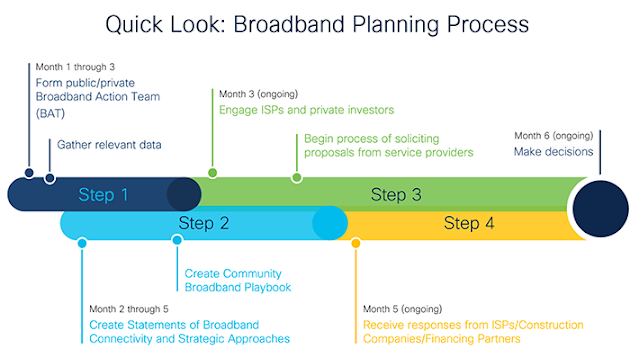As new Federal funding is released to help communities bridge the digital divide, you’ll need to gain a strong understanding of the solutions and deployment options available. Often overlooked, however, is the need to develop and commit to a realistic and inclusive broadband planning process. One that acknowledges the broad variety of stakeholders you’ll encounter and offers a realistic timeline to meet funding mandates. You’ll also need a strong leader. But who should lead and what should the process look like?
Why broadband planning is critical
As a licensed Landscape Architect and environmental planner, I’ve had the opportunity to work with state and local government leaders on a variety of infrastructure projects. In each case, we created and adhered to a detailed planning process. The projects ranged from a few acres to 23,000 acres, from roadways and utilities to commercial and residential communities. Even campuses and parks. In each case, sticking to a detailed planning process made things go smoother, resulting in a more successful project.
As critical infrastructure, broadband projects should adopt the same approach. You’ll benefit greatly by leveraging a well thought out collaborative planning model. Your stress levels will be reduced, your stakeholders happier, and the outcome more resilient and sustainable.Using a collaborative planning model helps accomplish this by:
◉ Establishing a clear vision and goals
◉ Limiting the scope of the project, preventing “scope-creep”
◉ Creating dedicated milestones to keep you on track
◉ Providing transparency for all stakeholders
◉ Setting a realistic timeline to better plan and promote your project.
Using a collaborative broadband planning process also creates a reference source for media outreach and promotion as milestones are reached. Lastly, by having a recorded process, funding mandates or data reporting can be more easily reported, keeping you and your team in compliance.
Who should lead broadband planning?
My involvement in traditional infrastructure planning has allowed me to experience first-hand how comfortable government personnel are in leading large-scale projects. Why are they? Because:
◉ They’re well versed in local ordinances, regulatory laws, and community standards
◉ They understand their community and its people
◉ They have established relationships that cross the public and private sector.
That’s why I, and many others in the IT industry, feel these same state and local government leaders can offer the most success leading broadband planning in their communities.
In addition, those in planning-specific positions are especially suited to do so, having unique skill sets that address:
◉ What type of infrastructure is needed and where to locate it
◉ Gathering realistic data via surveys, GIS mapping, and canvassing
◉ Construction issues that may serve as potential roadblocks or opportunities
◉ Understanding potential legal and maintenance issues.
A realistic broadband planning process
To help our partners in the public and private sectors achieve greater success in their broadband efforts, we’ve created a new guide. It outlines a realistic, inclusive broadband planning process, including suggested timelines and milestones.







0 comments:
Post a Comment